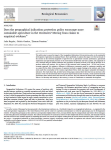Regolo J., Gendre C., Poméon T. (2025). Does the geographical indications protection policy encourage more sustainable agriculture in the territories? Moving from claims to empirical evidence. Ecological Economics, 01/01/2025, vol. 238, p. 108717.
https://doi.org/10.1016/j.ecolecon.2025.108717
https://doi.org/10.1016/j.ecolecon.2025.108717
| Titre : | Does the geographical indications protection policy encourage more sustainable agriculture in the territories? Moving from claims to empirical evidence (2025) |
| Auteurs : | J. Regolo ; C. Gendre ; T. Poméon |
| Type de document : | Article |
| Dans : | Ecological Economics (vol. 238, 2025) |
| Article en page(s) : | p. 108717 |
| Langues : | Anglais |
| Langues du résumé : | Anglais |
| Catégories : |
Catégories principales 04 - DEVELOPPEMENT LOCAL ET REGIONAL ; 4.3 - Appellations liées au Territoire. Produits du Terroir. QualitéThésaurus IAMM INDICATION GEOGRAPHIQUE PROTEGEE ; LABEL DE QUALITE ; AGRICULTURE ; DURABILITE ; TERRITOIRE ; FRANCE |
| Résumé : | This article aims to assess the impact of the Geographical Indications (GIs) protection policy on the sustainable development of agriculture in mainland France. More specifically, it analyses the impact over the last decade of the increase in the territorial magnitude of agri-food GIs on agricultural economic performance, agricultural employment and agricultural pressures on the environment (biodiversity and water quality). The magnitude of GIs is assessed using two distinct indicators: the proportion of farmers involved in GIs and the diversity of GI products within each territory. We use data at a fine territorial scale (cantonal level - NUTS4) and a meso-economic approach. We estimate a difference in differences econometric model to continuous variables, and we control for the effect of the presence of operators involved in organic farming in the territory, and of payments under the second pillar of the Common Agricultural Policy, which may impact sustainable development indicators. The results show that, all other factors being equal, cantons where there has been an increase in the presence of GIs over the last decade have seen greater improvements in their economic, social and environmental performance than cantons where there has been no increase. They also indicate the distinct and complementary effects of GI diversity and intensity in the territory, in terms of contribution to sustainable development. |
| Cote : | En ligne |
| URL / DOI : | https://doi.org/10.1016/j.ecolecon.2025.108717 |







